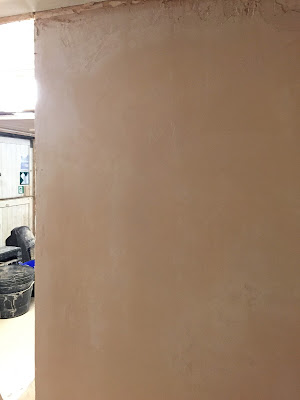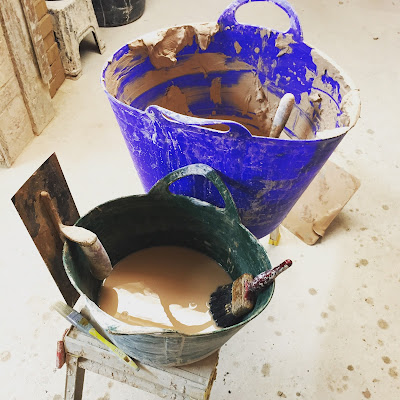To secure the roof sheets we needed something to screw them into. The existing purlins were L shaped, but the wrong way round, so the sheets would only rest on the top of the L if that makes any sense. After getting some advice from the roofing sheet company, we decided to fix some timbers to the purlins, to give something more supportive for the sheets to be screwed into. That probably didn't make any sense, but hopefully these photos will!
We used coach screws (screws with a hexagonal head) which meant that it was impossible to strip the heads of the screws. You do need a special drill adapter for these though, although this was only £5.
Hubby went along ahead of me drilling holes through the existing steel purlins at roughly 40cm spacings. Note - don't use the hammer function on the drill for drilling through steel!
I then followed up behind attaching timber tile battens (approx 50x25mm) that had been tanalised (pressure treated to help resist rotting) by screwing from the underside.
To attach the roof sheets, we rigged up some string to run over the top of battens so that we would be able to tell from the top where to screw into.
We put 3 or 4 sheets on loosely first to make sure they were heading in the right direction. It's really important to get the first one on right as you can't really make a big angle change halfway down the roof as the sheets lap squarely. You could line it up with the edge of the garage, but there is a good chance this isn't perfectly square.
We attached the sheets with self tapping roofing screws into battens in every trough of the sheet. We also used self tapping stitching screws to join two sheets together where they lapped. All the screws have washers on them, which need to be compressed just the right amount. It was easy enough to do though.
 |
| One side done! |
 |
| All the necessary tools and fixings. We borrowed our friends cordless drill for the job - it was amazing! |
We attached all the sheets, and then did the apex pieces last. Hubby was brave and climbed on top of the roof - eek!
And it's finished!
Tools:
- Power drill - borrowed
- Ladders - already owned
- Hex drill attachment - £5
- Nibbler drill attachment to cut the sheets - £40
Materials:
- Metal sheeting, apex, roofing screws, foam fillers £628.89 incl. delivery
- Timber tile battens 8No. 50 x 25 x 2400mm £16.54
- Coach screws £5
- String - already owned
TOTAL £695.43
This was money soooooo well spent. It makes me happy every time I go in the garage and it's dry. This was top spec sheeting (0.7mm thick with plastisol PVC coating), and came in way cheaper than the original quote we had for someone to do all the work (£2000! :-o ) Obviously, it required some leg work from us(!), and took two whole weekends, but my gosh I love it. Who knew it was possible to love a garage so much! Haha!



























